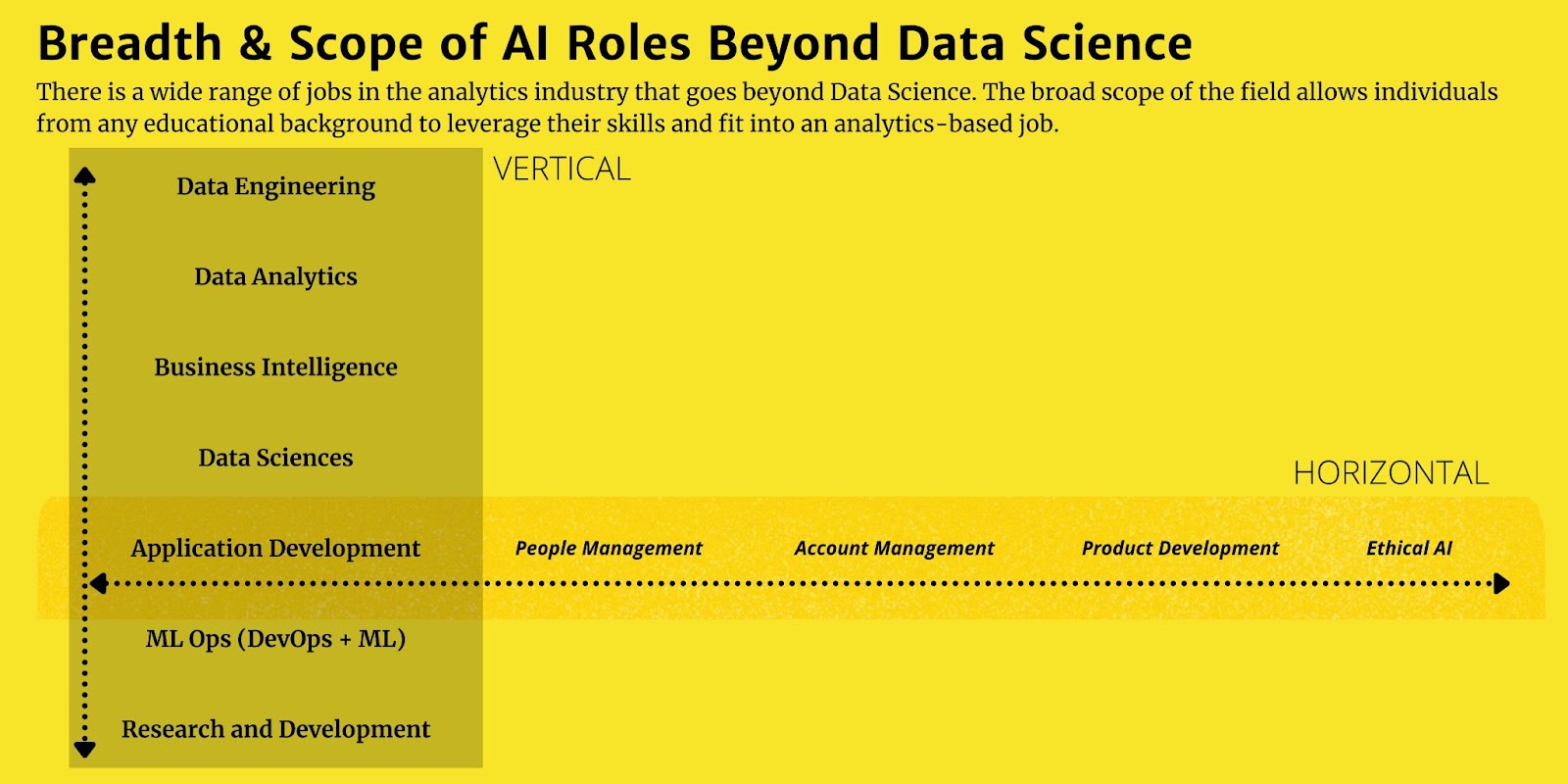By: Anirban Nandi
AI is no stranger to workplaces today. Fifty-three percent of global leaders have integrated or are integrating AI into their workforce to enhance their business insights. While IDC has predicted that by 2022, 75% of enterprises will have embedded intelligent automation into technology and process development, the key aspect to consider is how and through which job roles organizations are going about incorporating AI in their workforce.
Recent trends point towards broadening the scope of AI-driven roles in various parts of the workforce. This entails data science job roles spanning across the horizontal along with the vertical pillars of an organization. With the increased integration of AI and Data Science teams in organizations, it is important for organizations and aspiring data science employees to understand the breadth of job roles.
Many leaders are under the fallacy that AI and analytics can do with just data scientists, but the field is not limited to them. In fact, it is not even limited to engineers or individuals with a data science background. The broad scope of the field allows individuals from any educational background to leverage their skills and fit into an analytics-based job.
The analytics industry has job roles in various subjects for both technical and non-technical backgrounds. Let’s discuss these roles.

Roles in Data Engineering
Chief Data Officer
A member of the C-suite, a CDO, leads the utilization, governance, and implementation of data across the organization. They are responsible for creating a data management system and instilling a culture of data sharing and data analytics-based problem-solving.
Data Engineer
Data engineers are responsible for pulling in the required data for the work. This includes making data accessible to the organization, collecting data and making it available for analysis. Data engineers ensure this by standardizing and automating the data collection process. They are also responsible for designing, building, testing and maintaining data management systems to store and manage the data.
Data Collection Specialist
Working closely with data analytics, data collection specialists collect data by creating and administering surveys, research, and interviews. They review and clean the data received and present the data using tools such as Microsoft Excel and PowerPoint.
Database Administrator
As the title suggests, database administrators are responsible for managing the systems that store the data for organizations. They organize the data systems, secure data, and find better infrastructural ways to store the data and provide access to relevant stakeholders.
Roles in Data Analytics
Chief Analytics Officer
A CAO is a senior manager responsible for analytics operations in the organisation. They lead the process of digital transformation by making data-driven decisions backed by data science techniques. They also develop the warehouse as a central repository for all information within the organisation. While CDOs are responsible for managing data and driving maximum value from data, CAOs lead data analytics and derive data insights.
Data Analyst
A data analyst oversees designing and maintaining the data systems and database. They need to be fluent in codes to fix coding errors in the system. Data analysis is a statistics-based role, and analysts must be proficient in using statistical tools to interpret datasets and predict trends. The job role also involves mining data and reorganizing it so that both humans and machines can read it. Data analysts typically move on to senior data analysts, data scientists, analytics managers, and business analysts. They go on to become senior data analysts to move away from the detailed working of data analytics to take a broader view. This entails directing, organizing, and leading the data analytics projects in the organization.
Analytics Translator
Described as the new ‘must-have role’, an analytics translator bridges the gap between technical data engineering and operations-based departments. They present deep technical based insights in an easily understandable language to the other teams to ensure the data insights are translated into real impact at scale.
Roles in Business Intelligence
Business Intelligence Developer
Business intelligence developers help organizations get a sense of business acumen along with AI to optimize different processes involved in using AI for business enhancement. BI interfaces are great tools for leaders to study the past, present, and predictive views of the organization. The BI developer is essentially an engineer in charge of developing, deploying, and maintaining these BI interfaces. They need to be proficient in building query tools, data visualization, ad-hoc reporting and interactive dashboards that translate business requirements into technical instructions.
Data Visualization Engineer
Data visualization engineer develops and deploys user-friendly dashboard and data visualization tools using datasets from different sources. They work with complex data and use visualization tools to present it in a simple manner for everyone to understand.
Roles in Data Science
Data Scientist
Termed “the sexiest job of the 21st century” by the Harvard Business Review, data scientists are responsible for gathering relevant data from primary and secondary sources. They use machine learning and related tools to derive useful insights from the collected data. Data scientists develop, maintain, and evaluate AI solutions, clean & organize big data, and use analytical and statistical tools to identify patterns. Data scientists need to be proficient in programming languages, such as Python and Java. While data analysts work with structured data to solve problems, data scientists are involved in prescriptive and predictive analysis. They deal with raw data to make predictions about the future.
Machine Learning Engineer
ML Engineers are essential to implementing, building, and running algorithms and softwares in an organization. They are experts at coding, problem-solving and using data inputs provided by analysts to create a successful algorithm. In addition, they are responsible for building AI systems that can develop algorithms capable of making predictions.
Deep Learning Engineer
Deep learning engineers are specialists using deep learning for programming tasks related to AI. They are responsible for developing systems that can transfer data efficiently. They do this by writing complex codes to direct parts of the neural network.
Computer Vision Engineer
Computer vision engineers leverage software to process and analyze tons of data. They are responsible for designing and creating image processing and visualization platforms. Additionally, they develop deep learning frameworks to solve problems and use data to support the automation of predictive decision making through visuals.
Machine Learning Architect
Machine learning architects lead the end-to-end architecture and development of machine learning solutions for the organization’s programs. They implement algorithms into pipelines that can be consumed at scale. They are also responsible for creating scalable microservices for backend solutions.
Roles in Application Development
Technical Product Manager
A technical product manager identifies and resolves business challenges in the organization. They are responsible for managing the entire lifecycle of an AI-based product and transforming business strategies into well-defined products. This entails working with different teams to ensure a smooth product development process.
UI/UX Designer
A user interface or user experience designer can understand the user experience and designing interfaces accordingly. They collaborate with engineers and product managers to understand user requirements and work on design approaches to meet those needs. UX/UI designers have experience in working with data and a background in coding tools like JavaScript that they can use to generate personalized data-based visualizations.
Roles in MLOps
AI Engineer
An AI Engineer is an IT expert responsible for testing and deploying AI models. They understand and develop intelligent algorithms for the company to learn, analyze and predict future events, and are also a researcher expert in analyzing brain functions and building similar computational programs. Specialization in areas such as ML or DL is needed to be an AI engineer.
MLOps Engineer
An MLOps engineer is a software engineer with an added specialisation in the deployment and production parts of the data science process. They work with data scientists to bridge the gap between testing and production by using both data engineering and DevOps.
Roles in Research and Development
Research Scientist
Research scientists are responsible for conducting market research for the AI teams. They are involved in designing and analysing information. The job role entails extensive research in their domain wise fields such as NLP, computer vision, applied mathematics, computational statistics, and more. This makes it integral for research scientists to hold a post-graduate or a PhD degree. Moreover, they explore new ways and systems to solve problems and apply for patents in AI-related domains.
They go on to become senior research scientists and principal research scientists.
Robotics Scientist
Robotics scientists are responsible for building and designing mechanical devices such as UAVs and UGV. In addition, they are responsible for building robots to automate small manual tasks, design operating systems and test operating functions. Robotic scientists need to be experienced in robotic or mechanical engineering and have a strong base in advanced mathematics, physical science, and computer-aided design.
Roles in Ethical AI
AI Ethicist
With companies dealing with larger data volumes and complex AI-based solutions, it is essential to have an AI ethicist to ensure adequate governance mechanisms are in place to address the ethical concerns of AI. They educate and guide the employees on adequate ethical practices and guard the organization against biased AI.
AI Policy Researcher
AI policy and ethics researchers work on anticipating long and short-term risks for technical ethics. Ethics teamwork with NGOs, academics, and other forums to explore AI-related issues in society.
Conclusion
The Burning Glass survey, based on the analysis of hundreds of job postings, revealed significant growth in job skills in 2021. A similar conclusion was derived by The World Economic Forum’s Future of Jobs report that found that new job positions are set to grow in the data science industry.
AI and data science have been considered to be technically complex fields that tend to scare away individuals from a non-technical background or enthusiasts wanting to work in the field. The new job roles in the market have opened up these sectors to people from different educational backgrounds to be a part of this dynamically growing industry.
It is integral for data science enthusiasts and potential data scientists to understand the breadth and scope of this industry. Unlike the usual set jobs, data science is dynamic and constantly growing into a layered sector that welcomes people in various fields. This is a welcoming area for individuals with varied educational backgrounds and degrees to try out new job roles and work on different projects.





